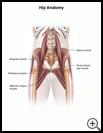
Snapping Hip Syndrome
________________________________________________________________________
KEY POINTS
- Snapping hip syndrome is a condition in which you feel a snap on the outer side or front of your hip as you walk or run.
- Since this problem usually happens because some muscles are too tight and some muscles are too loose, you will be given exercises to both strengthen and stretch your hip and thigh muscles.
- Snapping hip syndrome may be prevented by stretching and strengthening the muscles that cross the hip from the pelvis to the thigh bone.
________________________________________________________________________
What is snapping hip syndrome?
Snapping hip syndrome is a condition in which you feel a snap on the outer side or front of your hip as you walk or run. It may happen once in awhile or it may happen all the time.
What is the cause?
Several muscles, tendons, and ligaments cross the hip from the thigh bone to the pelvis. Tendons are strong bands of tissue that attach muscle to bone. Ligaments connect one bone to another to form the joints. If one of these muscles, tendons, or ligaments is too tight or too loose, it can cause snapping hip syndrome. The problem may happen after an injury, or if you do certain activities over and over, such as ballet.
What are the symptoms?
You feel snapping in your hip as you walk or run. You may hear a click or a pop, but usually there is no pain.
How is it diagnosed?
Your healthcare provider will ask about your symptoms and medical history and examine you. Tests may include:
- X-rays
- MRI, which uses a strong magnetic field and radio waves to show detailed pictures of the bones
How is it treated?
Since this problem usually happens because some muscles are too tight and some muscles are too loose, you will be given exercises to both strengthen and stretch your hip and thigh muscles. Follow your provider’s instructions for doing exercises to help you recover.
Take an anti-inflammatory medicine, such as ibuprofen, as directed by your provider. Nonsteroidal anti-inflammatory medicines (NSAIDs) may cause stomach bleeding and other problems. These risks increase with age. Read the label and take as directed. Unless recommended by your healthcare provider, do not take for more than 10 days.
If your hip is painful, put an ice pack, gel pack, or package of frozen vegetables wrapped in a cloth on the area every 3 to 4 hours for up to 20 minutes at a time until the pain goes away.
If you keep having pain, your provider may give you a shot of a steroid medicine. Rarely, you may need surgery to relieve the pain.
Follow the full course of treatment prescribed by your healthcare provider. Ask your provider:
- How long it will take to recover
- If there are activities you should avoid and when you can return to your normal activities
- How to take care of yourself at home
- What symptoms or problems you should watch for and what to do if you have them
Make sure you know when you should come back for a checkup. Keep all appointments for provider visits or tests.
How can I prevent snapping hip syndrome?
Snapping hip syndrome may be prevented by stretching and strengthening the muscles that cross the hip from the pelvis to the thigh bone.

